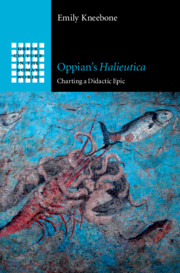Book contents
- Oppian’s Halieutica
- Greek Culture in the Roman World
- Oppian’s Halieutica
- Copyright page
- Epigraph
- Contents
- Acknowledgements
- Introduction: On Fishing
- Part I Didactic Poetry
- Part II Morality at Sea
- Part III Humans and Animals
- Chapter 7 Epic Similes
- Chapter 8 Analogical Animals
- Chapter 9 Humans and Other Animals
- Part IV The World Is a Sea
- Bibliography
- Subject Index
- Index Locorum
Chapter 8 - Analogical Animals
from Part III - Humans and Animals
Published online by Cambridge University Press: 24 September 2020
- Oppian’s Halieutica
- Greek Culture in the Roman World
- Oppian’s Halieutica
- Copyright page
- Epigraph
- Contents
- Acknowledgements
- Introduction: On Fishing
- Part I Didactic Poetry
- Part II Morality at Sea
- Part III Humans and Animals
- Chapter 7 Epic Similes
- Chapter 8 Analogical Animals
- Chapter 9 Humans and Other Animals
- Part IV The World Is a Sea
- Bibliography
- Subject Index
- Index Locorum
Summary
The next two chapters expand on the issues raised in Chapter 7: Oppian’s detailed engagement with the similes and metaphors of the Homeric epics, as well as his evident familiarity with ancient literary-critical debates about these practices; the close thematic connection between sequences and clusters of images in the Halieutica; the perceived degree of similarity between humans and other animals; and the ethical dimensions of that relationship, including the desire for bloodshed. This chapter focuses on the poet’s reflective engagement with the representation of animals in the Homeric epics, while Chapter 9 explores the ways in which the poet speaks also to a contemporary imperial Greek interest in the status of (non-human) animals.
- Type
- Chapter
- Information
- Oppian's HalieuticaCharting a Didactic Epic, pp. 252 - 299Publisher: Cambridge University PressPrint publication year: 2020

